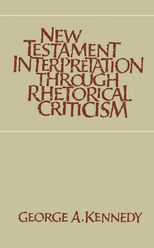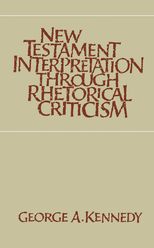New Testament Interpretation Through Rhetorical Criticism
New Testament Interpretation Through Rhetorical Criticism
Cite
Abstract
This book provides readers of the Bible with an important tool for understanding the Scriptures. Based on the theory and practice of Greek rhetoric in the New Testament, the book's approach acknowledges that New Testament writers wrote to persuade an audience of the truth of their messages. These writers employed rhetorical conventions that were widely known and imitated in the society of the times. Sometimes confirming but often challenging common interpretations of texts, this is a systematic study of the rhetorical composition of the New Testament. As a complement to form criticism, historical criticism, and other methods of biblical analysis, rhetorical criticism focuses on the text as we have it, and seeks to discover the basis of its powerful appeal and the intent of its authors. The book shows that biblical writers employed both “external” modes of persuasion, such as scriptural authority, the evidence of miracles, and the testimony of witnesses, and “internal” methods, such as ethos (authority and character of the speaker), pathos (emotional appeal to the audience), and logos (deductive and inductive argument in the text). The first chapter presents a survey of how rhetoric was taught in the New Testament period and outlines a rigorous method of rhetorical criticism that involves a series of steps. The book provides in succeeding chapters examples of rhetorical analysis, including close looks at the Sermon on the Mount, the Sermon on the Plain, Jesus's farewell to the disciples in John's Gospel, and the distinctive rhetoric of Jesus.
-
Front Matter
- One. Rhetorical Criticism
- Two. Deliberative Rhetoric: The Sermon on the Mount, the Sermon on the Plain, and the Rhetoric of Jesus
- Three. Epideictic Rhetoric: John 13–17
- Four. Judicial Rhetoric: Second Corinthians
- Five. The Rhetoric of the Gospels
-
Six.
The Speeches in Acts
- Seven. Thessalonians, Galatians, Romans
- Eight. Conclusion
-
End Matter
Sign in
Personal account
- Sign in with email/username & password
- Get email alerts
- Save searches
- Purchase content
- Activate your purchase/trial code
Institutional access
-
Sign in through your institution
- Sign in with a library card Sign in with username/password Recommend to your librarian
Institutional account management
Sign in as administratorPurchase
Our books are available by subscription or purchase to libraries and institutions.
Purchasing information| Month: | Total Views: |
|---|---|
| October 2022 | 1 |
| November 2022 | 2 |
| November 2022 | 4 |
| December 2022 | 2 |
| December 2022 | 2 |
| April 2023 | 4 |
| July 2023 | 3 |
| July 2023 | 5 |
| November 2023 | 2 |




Get help with access
Institutional access
Access to content on Oxford Academic is often provided through institutional subscriptions and purchases. If you are a member of an institution with an active account, you may be able to access content in one of the following ways:
IP based access
Typically, access is provided across an institutional network to a range of IP addresses. This authentication occurs automatically, and it is not possible to sign out of an IP authenticated account.
Sign in through your institution
Choose this option to get remote access when outside your institution. Shibboleth/Open Athens technology is used to provide single sign-on between your institution’s website and Oxford Academic.
If your institution is not listed or you cannot sign in to your institution’s website, please contact your librarian or administrator.
Sign in with a library card
Enter your library card number to sign in. If you cannot sign in, please contact your librarian.
Society Members
Society member access to a journal is achieved in one of the following ways:
Sign in through society site
Many societies offer single sign-on between the society website and Oxford Academic. If you see ‘Sign in through society site’ in the sign in pane within a journal:
If you do not have a society account or have forgotten your username or password, please contact your society.
Sign in using a personal account
Some societies use Oxford Academic personal accounts to provide access to their members. See below.
Personal account
A personal account can be used to get email alerts, save searches, purchase content, and activate subscriptions.
Some societies use Oxford Academic personal accounts to provide access to their members.
Viewing your signed in accounts
Click the account icon in the top right to:
Signed in but can't access content
Oxford Academic is home to a wide variety of products. The institutional subscription may not cover the content that you are trying to access. If you believe you should have access to that content, please contact your librarian.
Institutional account management
For librarians and administrators, your personal account also provides access to institutional account management. Here you will find options to view and activate subscriptions, manage institutional settings and access options, access usage statistics, and more.